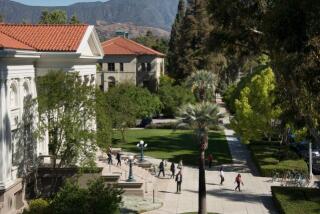College, 5 Students Settle Claims to Web Site Name
- Share via
Chalk one up for some enterprising students who outsmarted the Claremont McKenna College administration by taking their education seriously.
In 1998, the five students registered Claremont McKenna College as an Internet domain name and then launched a Web site. Neither they nor the college knew that the name had never been trademarked.
In a 2 1/2-year battle to get the domain name back, administrators drew accusations of trampling on the 1st Amendment and using bullying tactics to discourage free thought.
With an agreement announced Friday, the college finally has taken possession of the Internet name. But to get it, officials had to agree to student demands to pony up $120,000 to fund, among other things, a series of fellowships to foster entrepreneurial spirit and civil liberties.
“We’re happy with the result,” said David Enrich, a 21-year-old government major who helped launch https://www.claremontmckenna.com.
“We were told that we were breaking the law, that we would be disciplined and that legal action might follow. . . . It was clearly counter to the idea that college is supposed to encourage intellectual curiosity and disseminate knowledge.”
College President Pamela Gann downplayed the claims and insisted that “the only issue was protecting intellectual property rights.”
The agreement she signed promises to fund the annual fellowships and to pay $50,000 over 10 years for an independent student-operated Web site that will be named https://www.cmcstudents.com.
After the launch of www.claremontmckenna.com in late 1998, the administration’s attempt to take control of the site angered students, who said the liberal arts college, 35 miles east of Los Angeles, seemed to value its trademark claim more than the 1st Amendment.
And it struck Enrich and his friends as even more cockeyed because the college’s own mission statement pledges to support “intellectual vitality and the understanding of public policy issues” while educating students to lead “thoughtful and productive lives.”
Enrich said he and his friends were doing exactly that when their brainchild was born. “We were hanging out chatting at 4 a.m. in our room, and someone said, ‘I wonder who has claremontmckenna.com?’ and then we got excited and wondered what we could do with it.”
The students discovered that they could call up a domain registration site, stick in a credit card number and get the name within 36 hours for $150. “It didn’t even occur to us that they might make a big stink of it,” Enrich said.
Administrators at the 1,000-student campus didn’t think much of their ingenuity. They said the use of the name violated the college’s trademark rights and demanded that the students turn over the domain name in exchange for reimbursement of the $150 registration fee.
But the students did their homework.
“We discovered that the college didn’t even have a trademark on its name,” Enrich said. “It was pretty easy to go online and look it up.”
They marched into the office of Geoff Baum, who was then the campus information director, and said, “What trademark?”
“He looked at us kind of blankly,” Enrich recalled.
Enrich and his friends--Matt Grossman, David Alvillar, Devin Erhardt and A.J. Prager--said campus officials threatened to haul the group before the campus judicial board for discipline and hinted at possible legal action. Administrators denied both accusations.
Gann, whom students credited with being far more conciliatory on the domain name issue than her predecessor, Jack Stark, characterized the settlement as a “total win-win situation.”
“We have the trademark now, and in order to acknowledge their entrepreneurship, we established the fellowships,” she said.
Enrich’s group had launched the disputed Web site as an alternative to the official campus site, https://www.claremontmckenna.edu, which Enrich characterized as “just a brochure for prospective students.” It didn’t even have a calendar of student events or a directory of administrative phone numbers, both of which were posted on the student-created site, he said.
Dining hall menus, restaurant information and poetry soon followed. And even breaking news stories. When Gann was picked as the college president in 1999, Enrich said, “we found out about it before most of the administration and faculty and we posted it.”
More to Read
Sign up for Essential California
The most important California stories and recommendations in your inbox every morning.
You may occasionally receive promotional content from the Los Angeles Times.













